compression ratio DODGE RAM 1500 1998 2.G User Guide
[x] Cancel search | Manufacturer: DODGE, Model Year: 1998, Model line: RAM 1500, Model: DODGE RAM 1500 1998 2.GPages: 2627
Page 1407 of 2627
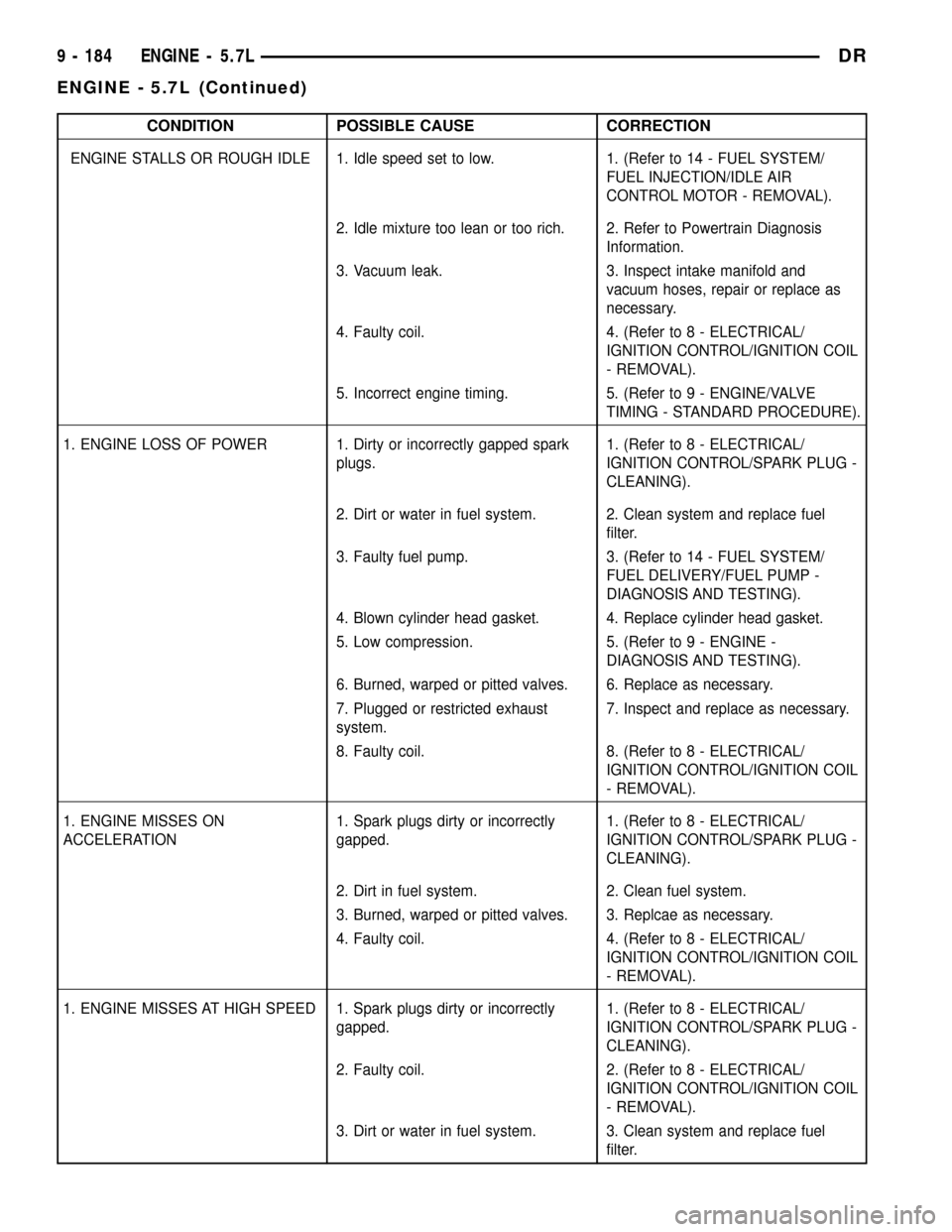
CONDITION POSSIBLE CAUSE CORRECTION
ENGINE STALLS OR ROUGH IDLE 1. Idle speed set to low. 1. (Refer to 14 - FUEL SYSTEM/
FUEL INJECTION/IDLE AIR
CONTROL MOTOR - REMOVAL).
2. Idle mixture too lean or too rich. 2. Refer to Powertrain Diagnosis
Information.
3. Vacuum leak. 3. Inspect intake manifold and
vacuum hoses, repair or replace as
necessary.
4. Faulty coil. 4. (Refer to 8 - ELECTRICAL/
IGNITION CONTROL/IGNITION COIL
- REMOVAL).
5. Incorrect engine timing. 5. (Refer to 9 - ENGINE/VALVE
TIMING - STANDARD PROCEDURE).
1. ENGINE LOSS OF POWER 1. Dirty or incorrectly gapped spark
plugs.1. (Refer to 8 - ELECTRICAL/
IGNITION CONTROL/SPARK PLUG -
CLEANING).
2. Dirt or water in fuel system. 2. Clean system and replace fuel
filter.
3. Faulty fuel pump. 3. (Refer to 14 - FUEL SYSTEM/
FUEL DELIVERY/FUEL PUMP -
DIAGNOSIS AND TESTING).
4. Blown cylinder head gasket. 4. Replace cylinder head gasket.
5. Low compression. 5. (Refer to 9 - ENGINE -
DIAGNOSIS AND TESTING).
6. Burned, warped or pitted valves. 6. Replace as necessary.
7. Plugged or restricted exhaust
system.7. Inspect and replace as necessary.
8. Faulty coil. 8. (Refer to 8 - ELECTRICAL/
IGNITION CONTROL/IGNITION COIL
- REMOVAL).
1. ENGINE MISSES ON
ACCELERATION1. Spark plugs dirty or incorrectly
gapped.1. (Refer to 8 - ELECTRICAL/
IGNITION CONTROL/SPARK PLUG -
CLEANING).
2. Dirt in fuel system. 2. Clean fuel system.
3. Burned, warped or pitted valves. 3. Replcae as necessary.
4. Faulty coil. 4. (Refer to 8 - ELECTRICAL/
IGNITION CONTROL/IGNITION COIL
- REMOVAL).
1. ENGINE MISSES AT HIGH SPEED 1. Spark plugs dirty or incorrectly
gapped.1. (Refer to 8 - ELECTRICAL/
IGNITION CONTROL/SPARK PLUG -
CLEANING).
2. Faulty coil. 2. (Refer to 8 - ELECTRICAL/
IGNITION CONTROL/IGNITION COIL
- REMOVAL).
3. Dirt or water in fuel system. 3. Clean system and replace fuel
filter.
9 - 184 ENGINE - 5.7LDR
ENGINE - 5.7L (Continued)
Page 1415 of 2627
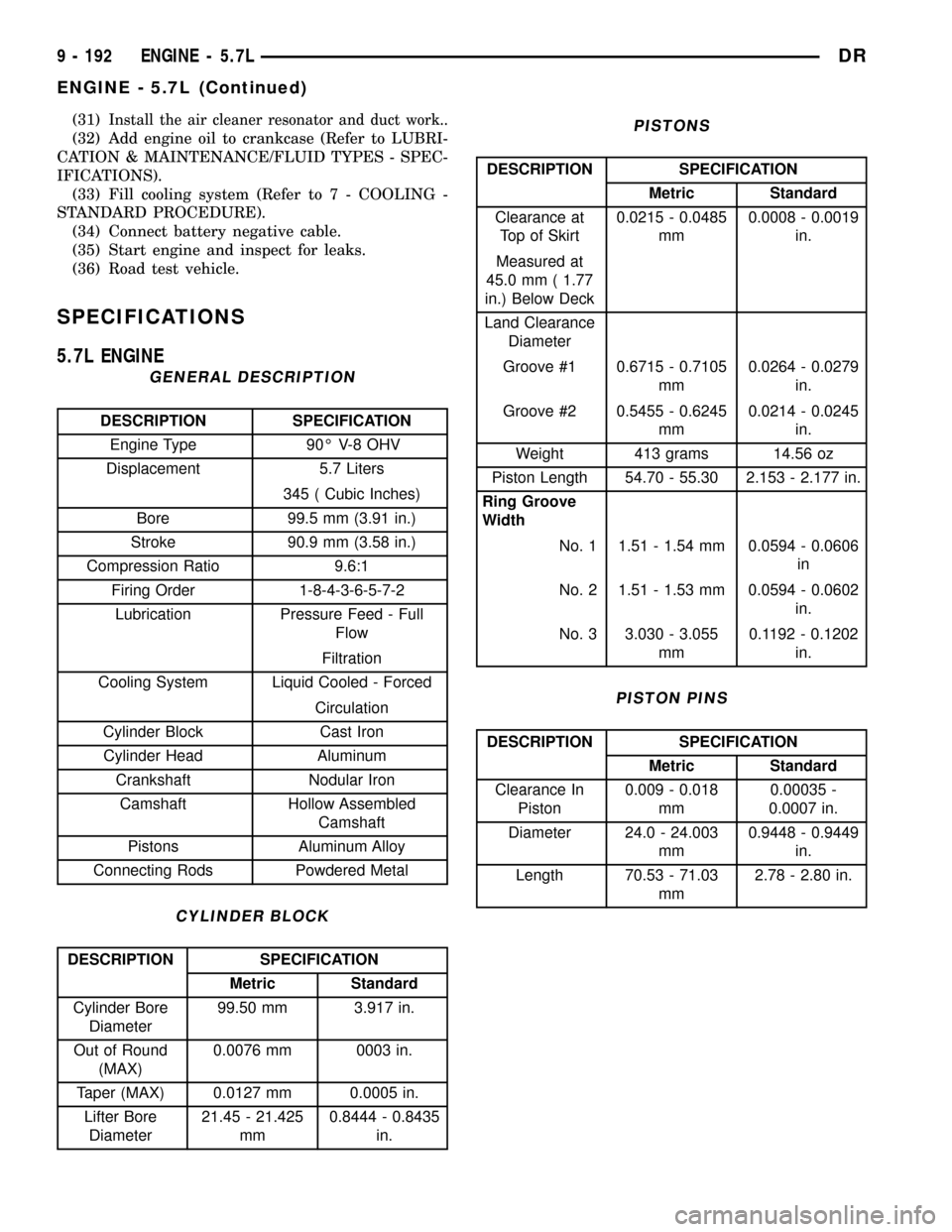
(31)Install the air cleaner resonator and duct work..
(32) Add engine oil to crankcase (Refer to LUBRI-
CATION & MAINTENANCE/FLUID TYPES - SPEC-
IFICATIONS).
(33) Fill cooling system (Refer to 7 - COOLING -
STANDARD PROCEDURE).
(34) Connect battery negative cable.
(35) Start engine and inspect for leaks.
(36) Road test vehicle.
SPECIFICATIONS
5.7L ENGINE
GENERAL DESCRIPTION
DESCRIPTION SPECIFICATION
Engine Type 90É V-8 OHV
Displacement 5.7 Liters
345 ( Cubic Inches)
Bore 99.5 mm (3.91 in.)
Stroke 90.9 mm (3.58 in.)
Compression Ratio 9.6:1
Firing Order 1-8-4-3-6-5-7-2
Lubrication Pressure Feed - Full
Flow
Filtration
Cooling System Liquid Cooled - Forced
Circulation
Cylinder Block Cast Iron
Cylinder Head Aluminum
Crankshaft Nodular Iron
Camshaft Hollow Assembled
Camshaft
Pistons Aluminum Alloy
Connecting Rods Powdered Metal
CYLINDER BLOCK
DESCRIPTION SPECIFICATION
Metric Standard
Cylinder Bore
Diameter99.50 mm 3.917 in.
Out of Round
(MAX)0.0076 mm 0003 in.
Taper (MAX) 0.0127 mm 0.0005 in.
Lifter Bore
Diameter21.45 - 21.425
mm0.8444 - 0.8435
in.
PISTONS
DESCRIPTION SPECIFICATION
Metric Standard
Clearance at
Top of Skirt0.0215 - 0.0485
mm0.0008 - 0.0019
in.
Measured at
45.0 mm ( 1.77
in.) Below Deck
Land Clearance
Diameter
Groove #1 0.6715 - 0.7105
mm0.0264 - 0.0279
in.
Groove #2 0.5455 - 0.6245
mm0.0214 - 0.0245
in.
Weight 413 grams 14.56 oz
Piston Length 54.70 - 55.30 2.153 - 2.177 in.
Ring Groove
Width
No. 1 1.51 - 1.54 mm 0.0594 - 0.0606
in
No. 2 1.51 - 1.53 mm 0.0594 - 0.0602
in.
No. 3 3.030 - 3.055
mm0.1192 - 0.1202
in.
PISTON PINS
DESCRIPTION SPECIFICATION
Metric Standard
Clearance In
Piston0.009 - 0.018
mm0.00035 -
0.0007 in.
Diameter 24.0 - 24.003
mm0.9448 - 0.9449
in.
Length 70.53 - 71.03
mm2.78 - 2.80 in.
9 - 192 ENGINE - 5.7LDR
ENGINE - 5.7L (Continued)
Page 1423 of 2627

þ Loss of engine power
þ Engine misfiring
þ Poor fuel economy
²Possible indications of the cylinder head gasket
leaking between a cylinder and an adjacent water
jacket are:
þ Engine overheating
þ Loss of coolant
þ Excessive steam (white smoke) emitting from
exhaust
þ Coolant foaming
CYLINDER-TO-CYLINDER LEAKAGE TEST
To determine if an engine cylinder head gasket is
leaking between adjacent cylinders, follow the proce-
dures in Cylinder Compression Pressure Test in this
section. An engine cylinder head gasket leaking
between adjacent cylinders will result in approxi-
mately a 50±70% reduction in compression pressure.
CYLINDER-TO-WATER JACKET LEAKAGE TEST
WARNING: USE EXTREME CAUTION WHEN THE
ENGINE IS OPERATING WITH COOLANT PRES-
SURE CAP REMOVED.
VISUAL TEST METHOD
With the engine cool, remove the coolant pressure
cap. Start the engine and allow it to warm up until
thermostat opens.
If a large combustion/compression pressure leak
exists, bubbles will be visible in the coolant.
COOLING SYSTEM TESTER METHOD
WARNING: WITH COOLING SYSTEM TESTER IN
PLACE, PRESSURE WILL BUILD UP FAST. EXCES-
SIVE PRESSURE BUILT UP, BY CONTINUOUS
ENGINE OPERATION, MUST BE RELEASED TO A
SAFE PRESSURE POINT. NEVER PERMIT PRES-
SURE TO EXCEED 138 kPa (20 psi).
Install Cooling System Tester 7700 or equivalent to
pressure cap neck. Start the engine and observe the
tester's pressure gauge. If gauge pulsates with every
power stroke of a cylinder a combustion pressure
leak is evident.
CHEMICAL TEST METHOD
Combustion leaks into the cooling system can also
be checked by using Bloc-Chek Kit C-3685-A or
equivalent. Perform test following the procedures
supplied with the tool kit.
REMOVAL
(1) Disconnect the battery negative cable.
(2) Drain cooling system.
(3) Remove the air cleaner resonator and duct
work.
(4) Remove the generator.
(5) Remove closed crankcase ventilation system.
(6) Disconnect the evaporation control system.
(7) Perform the Fuel System Pressure Release pro-
cedure (Refer to 14 - FUEL SYSTEM/FUEL DELIV-
ERY - STANDARD PROCEDURE). Disconnect the
fuel supply line (Refer to 14 - FUEL SYSTEM/FUEL
DELIVERY/QUICK CONNECT FITTING - STAN-
DARD PROCEDURE).
(8) Disconnect heater hoses.
(9) Remove cylinder head covers and gaskets.
(10) Remove intake manifold and throttle body as
an assembly.
(11) Remove rocker arm assemblies and push rods.
Identify to ensure installation in original locations.
(12) Remove the head bolts from each cylinder
head and remove cylinder heads. Discard the cylin-
der head gasket.
CLEANING
Clean all surfaces of cylinder block and cylinder
heads.
Clean cylinder block front and rear gasket surfaces
using a suitable solvent.
INSPECTION
(1) Inspect the cylinder head for out-of-flatness,
using a straightedge and a feeler gauge. If tolerances
exceed 0.0508 mm (0.002 in.) replace the cylinder
head.
(2) Inspect the valve seats for damage. Service the
valve seats as necessary.
(3) Inspect the valve guides for wear, cracks or
looseness. If either condition exist, replace the cylin-
der head.
(4) Inspect pushrods. Replace worn or bent push-
rods.
INSTALLATION
(1) Clean all surfaces of cylinder block and cylin-
der heads.
(2) Clean cylinder block front and rear gasket sur-
faces using a suitable solvent.
CAUTION: The head gaskets are not interchange-
able between left and right sides. They are marked
ªLº and ªRº to indicate left and right sides.
(3) Position new cylinder head gaskets onto the
cylinder block.
9 - 200 ENGINE - 5.7LDR
CYLINDER HEAD (Continued)
Page 1457 of 2627
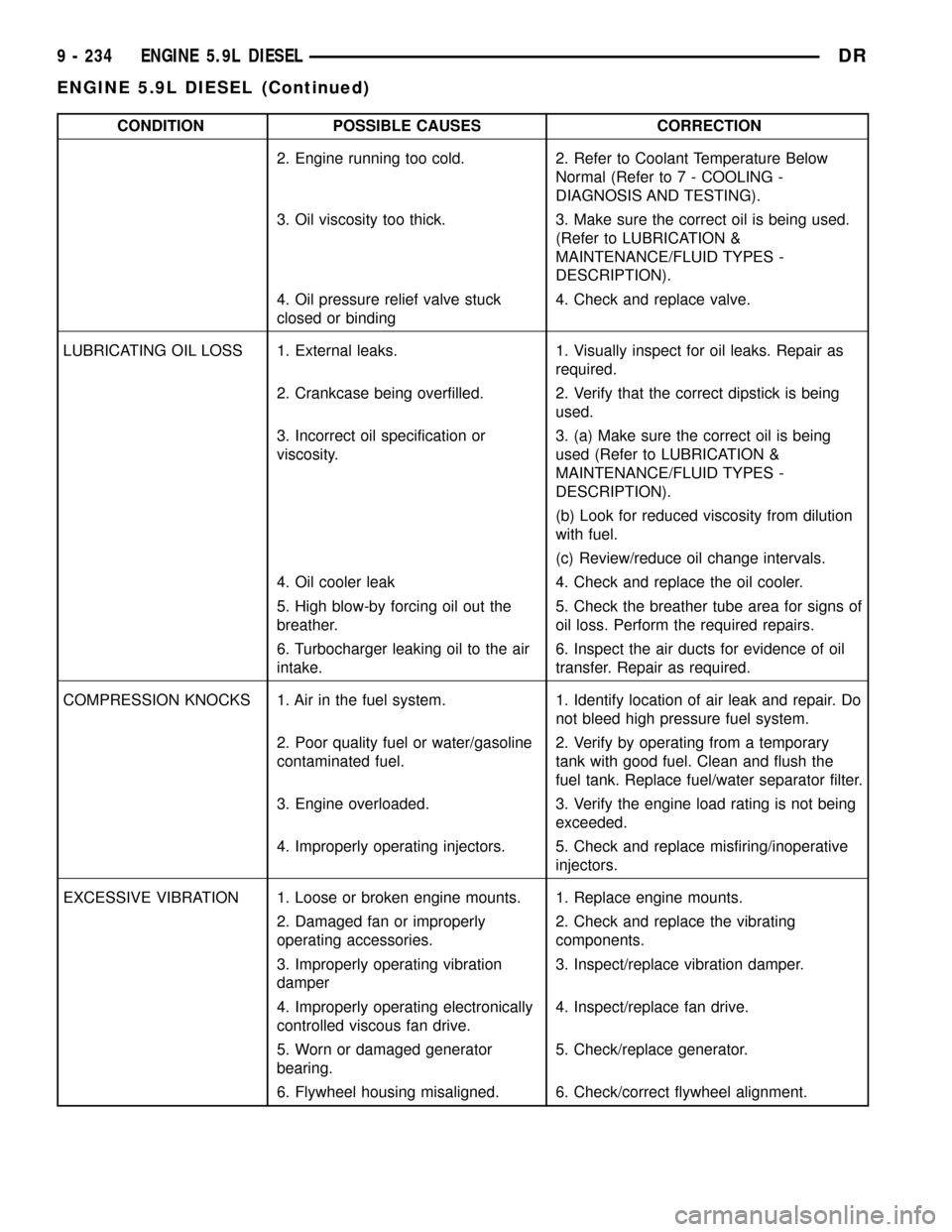
CONDITION POSSIBLE CAUSES CORRECTION
2. Engine running too cold. 2. Refer to Coolant Temperature Below
Normal (Refer to 7 - COOLING -
DIAGNOSIS AND TESTING).
3. Oil viscosity too thick. 3. Make sure the correct oil is being used.
(Refer to LUBRICATION &
MAINTENANCE/FLUID TYPES -
DESCRIPTION).
4. Oil pressure relief valve stuck
closed or binding4. Check and replace valve.
LUBRICATING OIL LOSS 1. External leaks. 1. Visually inspect for oil leaks. Repair as
required.
2. Crankcase being overfilled. 2. Verify that the correct dipstick is being
used.
3. Incorrect oil specification or
viscosity.3. (a) Make sure the correct oil is being
used (Refer to LUBRICATION &
MAINTENANCE/FLUID TYPES -
DESCRIPTION).
(b) Look for reduced viscosity from dilution
with fuel.
(c) Review/reduce oil change intervals.
4. Oil cooler leak 4. Check and replace the oil cooler.
5. High blow-by forcing oil out the
breather.5. Check the breather tube area for signs of
oil loss. Perform the required repairs.
6. Turbocharger leaking oil to the air
intake.6. Inspect the air ducts for evidence of oil
transfer. Repair as required.
COMPRESSION KNOCKS 1. Air in the fuel system. 1. Identify location of air leak and repair. Do
not bleed high pressure fuel system.
2. Poor quality fuel or water/gasoline
contaminated fuel.2. Verify by operating from a temporary
tank with good fuel. Clean and flush the
fuel tank. Replace fuel/water separator filter.
3. Engine overloaded. 3. Verify the engine load rating is not being
exceeded.
4. Improperly operating injectors. 5. Check and replace misfiring/inoperative
injectors.
EXCESSIVE VIBRATION 1. Loose or broken engine mounts. 1. Replace engine mounts.
2. Damaged fan or improperly
operating accessories.2. Check and replace the vibrating
components.
3. Improperly operating vibration
damper3. Inspect/replace vibration damper.
4. Improperly operating electronically
controlled viscous fan drive.4. Inspect/replace fan drive.
5. Worn or damaged generator
bearing.5. Check/replace generator.
6. Flywheel housing misaligned. 6. Check/correct flywheel alignment.
9 - 234 ENGINE 5.9L DIESELDR
ENGINE 5.9L DIESEL (Continued)
Page 1467 of 2627
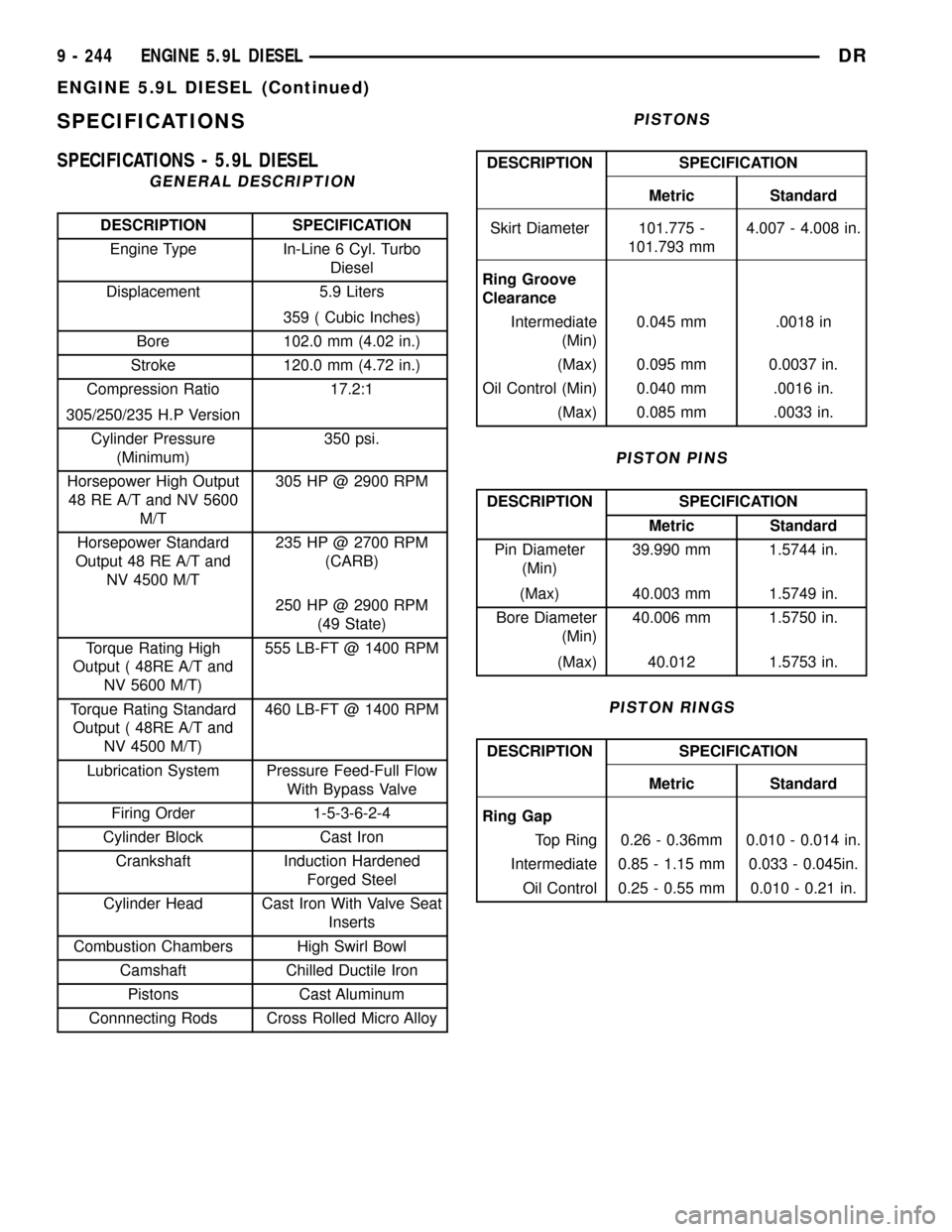
SPECIFICATIONS
SPECIFICATIONS - 5.9L DIESEL
GENERAL DESCRIPTION
DESCRIPTION SPECIFICATION
Engine Type In-Line 6 Cyl. Turbo
Diesel
Displacement 5.9 Liters
359 ( Cubic Inches)
Bore 102.0 mm (4.02 in.)
Stroke 120.0 mm (4.72 in.)
Compression Ratio 17.2:1
305/250/235 H.P Version
Cylinder Pressure
(Minimum)350 psi.
Horsepower High Output
48 RE A/T and NV 5600
M/T305 HP @ 2900 RPM
Horsepower Standard
Output 48 RE A/T and
NV 4500 M/T235 HP @ 2700 RPM
(CARB)
250 HP @ 2900 RPM
(49 State)
Torque Rating High
Output ( 48RE A/T and
NV 5600 M/T)555 LB-FT @ 1400 RPM
Torque Rating Standard
Output ( 48RE A/T and
NV 4500 M/T)460 LB-FT @ 1400 RPM
Lubrication System Pressure Feed-Full Flow
With Bypass Valve
Firing Order 1-5-3-6-2-4
Cylinder Block Cast Iron
Crankshaft Induction Hardened
Forged Steel
Cylinder Head Cast Iron With Valve Seat
Inserts
Combustion Chambers High Swirl Bowl
Camshaft Chilled Ductile Iron
Pistons Cast Aluminum
Connnecting Rods Cross Rolled Micro Alloy
PISTONS
DESCRIPTION SPECIFICATION
Metric Standard
Skirt Diameter 101.775 -
101.793 mm4.007 - 4.008 in.
Ring Groove
Clearance
Intermediate
(Min)0.045 mm .0018 in
(Max) 0.095 mm 0.0037 in.
Oil Control (Min) 0.040 mm .0016 in.
(Max) 0.085 mm .0033 in.
PISTON PINS
DESCRIPTION SPECIFICATION
Metric Standard
Pin Diameter
(Min)39.990 mm 1.5744 in.
(Max) 40.003 mm 1.5749 in.
Bore Diameter
(Min)40.006 mm 1.5750 in.
(Max) 40.012 1.5753 in.
PISTON RINGS
DESCRIPTION SPECIFICATION
Metric Standard
Ring Gap
Top Ring 0.26 - 0.36mm 0.010 - 0.014 in.
Intermediate 0.85 - 1.15 mm 0.033 - 0.045in.
Oil Control 0.25 - 0.55 mm 0.010 - 0.21 in.
9 - 244 ENGINE 5.9L DIESELDR
ENGINE 5.9L DIESEL (Continued)
Page 1538 of 2627

OPERATION
Exhaust gas pressure and energy drive the tur-
bine, which in turn drives a centrifugal compressor
that compresses the inlet air, and forces the air into
the engine through the charge air cooler and plumb-
ing. Since heat is a by-product of this compression,
the air must pass through a charge air cooler to cool
the incoming air and maintain power and efficiency.
Increasing air flow to the engine provides:
²Improved engine performance
²Lower exhaust smoke density
²Improved operating economy
²Altitude compensation
²Noise reduction.
The turbocharger also uses a wastegate (Fig. 16),
which regulates intake manifold air pressure and
prevents over boosting at high engine speeds. When
the wastegate valve is closed, all of the exhaust gases
flow through the turbine wheel. As the intake mani-
fold pressure increases, the wastegate actuator opens
the valve, diverting some of the exhaust gases away
from the turbine wheel. This limits turbine shaft
speed and air output from the impeller.
The turbocharger is lubricated by engine oil that is
pressurized, cooled, and filtered. The oil is delivered
to the turbocharger by a supply line that is tapped
into the oil filter head. The oil travels into the bear-
ing housing, where it lubricates the shaft and bear-
ings (Fig. 17). A return pipe at the bottom of the
bearing housing, routes the engine oil back to the
crankcase.
The most common turbocharger failure is bearing
failure related to repeated hot shutdowns with inad-
equate ªcool-downº periods. A sudden engine shut
down after prolonged operation will result in the
transfer of heat from the turbine section of the tur-
bocharger to the bearing housing. This causes the oil
to overheat and break down, which causes bearing
and shaft damage the next time the vehicle is
started.
Letting the engine idle after extended operation
allows the turbine housing to cool to normal operat-
ing temperature. The following chart should be used
as a guide in determining the amount of engine idle
time required to sufficiently cool down the turbo-
charger before shut down, depending upon the type
of driving and the amount of cargo.
Fig. 16 Wastegate Operation
1 - SIGNAL LINE
2 - EXHAUST BYPASS VALVE
3 - WASTEGATE
4 - EXHAUST
5 - TURBINE
DREXHAUST SYSTEM 11 - 13
TURBOCHARGER (Continued)
Page 1939 of 2627
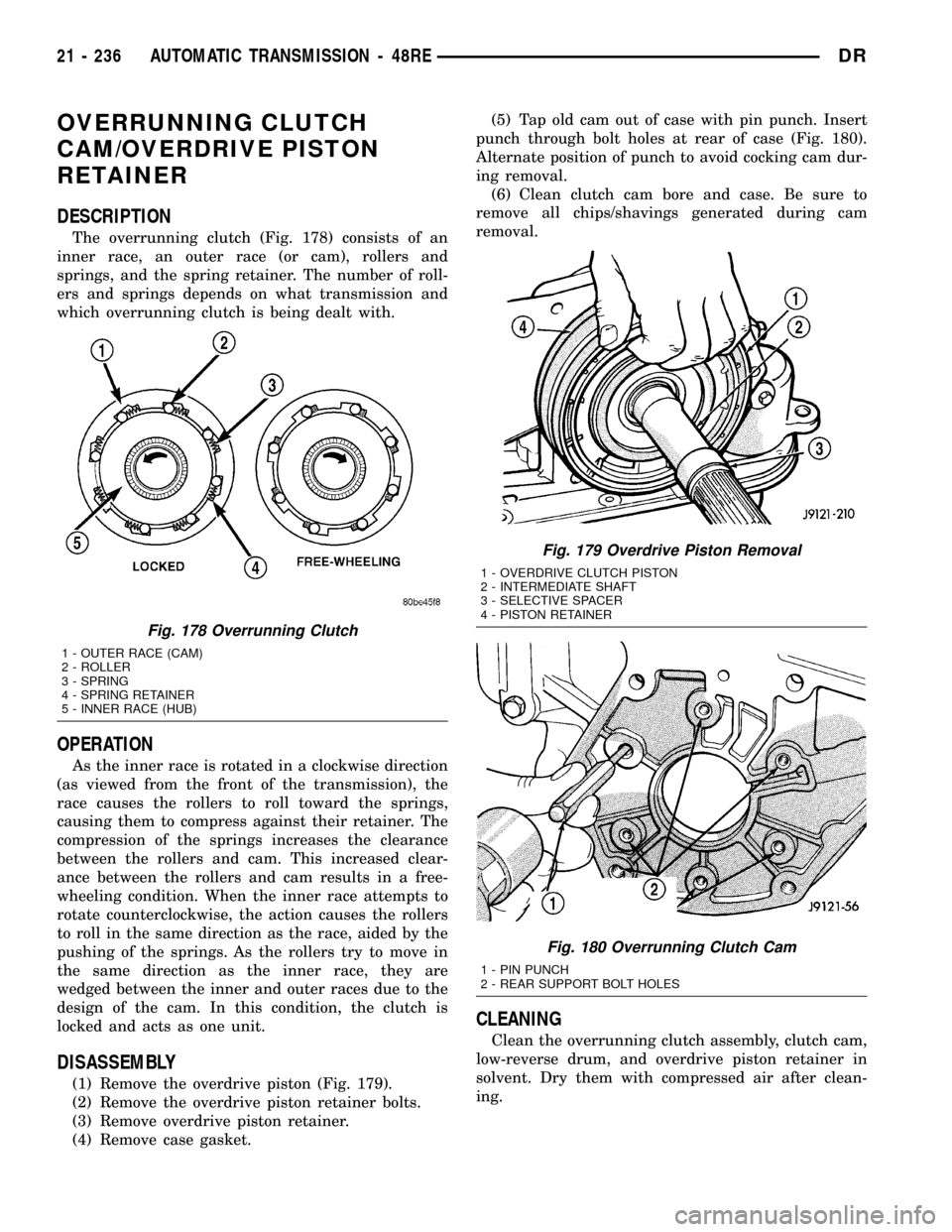
OVERRUNNING CLUTCH
CAM/OVERDRIVE PISTON
RETAINER
DESCRIPTION
The overrunning clutch (Fig. 178) consists of an
inner race, an outer race (or cam), rollers and
springs, and the spring retainer. The number of roll-
ers and springs depends on what transmission and
which overrunning clutch is being dealt with.
OPERATION
As the inner race is rotated in a clockwise direction
(as viewed from the front of the transmission), the
race causes the rollers to roll toward the springs,
causing them to compress against their retainer. The
compression of the springs increases the clearance
between the rollers and cam. This increased clear-
ance between the rollers and cam results in a free-
wheeling condition. When the inner race attempts to
rotate counterclockwise, the action causes the rollers
to roll in the same direction as the race, aided by the
pushing of the springs. As the rollers try to move in
the same direction as the inner race, they are
wedged between the inner and outer races due to the
design of the cam. In this condition, the clutch is
locked and acts as one unit.
DISASSEMBLY
(1) Remove the overdrive piston (Fig. 179).
(2) Remove the overdrive piston retainer bolts.
(3) Remove overdrive piston retainer.
(4) Remove case gasket.(5) Tap old cam out of case with pin punch. Insert
punch through bolt holes at rear of case (Fig. 180).
Alternate position of punch to avoid cocking cam dur-
ing removal.
(6) Clean clutch cam bore and case. Be sure to
remove all chips/shavings generated during cam
removal.
CLEANING
Clean the overrunning clutch assembly, clutch cam,
low-reverse drum, and overdrive piston retainer in
solvent. Dry them with compressed air after clean-
ing.
Fig. 178 Overrunning Clutch
1 - OUTER RACE (CAM)
2 - ROLLER
3 - SPRING
4 - SPRING RETAINER
5 - INNER RACE (HUB)
Fig. 179 Overdrive Piston Removal
1 - OVERDRIVE CLUTCH PISTON
2 - INTERMEDIATE SHAFT
3 - SELECTIVE SPACER
4 - PISTON RETAINER
Fig. 180 Overrunning Clutch Cam
1 - PIN PUNCH
2 - REAR SUPPORT BOLT HOLES
21 - 236 AUTOMATIC TRANSMISSION - 48REDR
Page 2569 of 2627

²Engine RPMÐ A live reading of engine RPM
to aid the user in accessing the Similar Conditions
Window.
²Adaptive Memory FactorÐ The PCM utilizes
both Short Term Compensation and Long Term Adap-
tive to calculate the Adaptive Memory Factor for
total fuel correction.
²Upstream O2S VoltsÐ A live reading of the
Oxygen Sensor to indicate its performance. For
example, stuck lean, stuck rich, etc.
²SCW Time in Window (Similar Conditions
Window Time in Window)Ð A timer used by the
PCM that indicates that, after all Similar Conditions
have been met, if there has been enough good engine
running time in the SCW without failure detected.
This timer is used to increment a Good Trip.
²Fuel System Good Trip CounterÐATrip
Counter used to turn OFF the MIL for Fuel System
DTCs. To increment a Fuel System Good Trip, the
engine must be in the Similar Conditions Window,
Adaptive Memory Factor must be less than cali-
brated threshold and the Adaptive Memory Factor
must stay below that threshold for a calibrated
amount of time.
²Test Done This TripÐ Indicates that the
monitor has already been run and completed during
the current trip.
MISFIRE
²Same Misfire Warm-Up StateÐ Indicates if
the misfire occurred when the engine was warmed up
(above 160É F).
²In Similar Misfire WindowÐ An indicator
that 'Absolute MAP When Misfire Occurred' and
'RPM When Misfire Occurred' are all in the same
range when the failure occurred. Indicated by switch-
ing from 'NO' to 'YES'.
²Absolute MAP When Misfire OccurredÐ
The stored MAP reading at the time of failure.
Informs the user at what engine load the failure
occurred.
²Absolute MAPÐ A live reading of engine load
to aid the user in accessing the Similar Conditions
Window.
²RPM When Misfire OccurredÐ The stored
RPM reading at the time of failure. Informs the user
at what engine RPM the failure occurred.
²Engine RPMÐ A live reading of engine RPM
to aid the user in accessing the Similar Conditions
Window.
²Adaptive Memory FactorÐ The PCM utilizes
both Short Term Compensation and Long Term Adap-
tive to calculate the Adaptive Memory Factor for
total fuel correction.
²200 Rev CounterÐ Counts 0±100 720 degree
cycles.²SCW Cat 200 Rev CounterÐ Counts when in
similar conditions.
²SCW FTP 1000 Rev CounterÐ Counts 0±4
when in similar conditions.
²Misfire Good Trip CounterÐ Counts up to
three to turn OFF the MIL.
²Misfire DataÐ Data collected during test.
²Test Done This TripÐ Indicates YES when the
test is done.
OPERATION - NON-MONITORED CIRCUITS
The PCM does not monitor the following circuits,
systems and conditions that could have malfunctions
causing driveability problems. The PCM might not
store diagnostic trouble codes for these conditions.
However, problems with these systems may cause the
PCM to store diagnostic trouble codes for other sys-
tems or components.EXAMPLE:a fuel pressure
problem will not register a fault directly, but could
cause a rich/lean condition or misfire. This could
cause the PCM to store an oxygen sensor or misfire
diagnostic trouble code
FUEL PRESSURE
The fuel pressure regulator controls fuel system
pressure. The PCM cannot detect a clogged fuel
pump inlet filter, clogged in-line fuel filter, or a
pinched fuel supply or return line. However, these
could result in a rich or lean condition causing the
PCM to store an oxygen sensor or fuel system diag-
nostic trouble code.
SECONDARY IGNITION CIRCUIT
The PCM cannot detect an inoperative ignition coil,
fouled or worn spark plugs, ignition cross firing, or
open spark plug cables.
CYLINDER COMPRESSION
The PCM cannot detect uneven, low, or high engine
cylinder compression.
EXHAUST SYSTEM
The PCM cannot detect a plugged, restricted or
leaking exhaust system, although it may set a fuel
system fault.
FUEL INJECTOR MECHANICAL MALFUNCTIONS
The PCM cannot determine if a fuel injector is
clogged, the needle is sticking or if the wrong injector
is installed. However, these could result in a rich or
lean condition causing the PCM to store a diagnostic
trouble code for either misfire, an oxygen sensor, or
the fuel system.
25 - 8 EMISSIONS CONTROLDR
EMISSIONS CONTROL (Continued)
Page 2594 of 2627

CLUTCH - DESCRIPTION, REAR........21-247
CLUTCH - DIAGNOSIS AND TESTING.......6-1
CLUTCH - DISASSEMBLY, FRONT.......21-205
CLUTCH - DISASSEMBLY, LOW/REVERSE . 21-384
CLUTCH - DISASSEMBLY, REAR........21-248
CLUTCH - INSPECTION, FRONT........21-206
CLUTCH - INSPECTION, LOW/REVERSE . . 21-385
CLUTCH - INSPECTION, REAR.........21-248
CLUTCH - OPERATION, FRONT.........21-205
CLUTCH - OPERATION, OVERDRIVE.....21-217
CLUTCH - OPERATION, REAR..........21-248
CLUTCH - SPECIFICATIONS...............6-5
CLUTCH - WARNING....................6-1
CLUTCH AND BAND OPERATION -
DIAGNOSIS AND TESTING, AIR
TESTING TRANSMISSION.............21-144
CLUTCH ASSEMBLY - ASSEMBLY, INPUT . 21-378
CLUTCH ASSEMBLY - DESCRIPTION,
INPUT............................21-373
CLUTCH ASSEMBLY - DISASSEMBLY,
INPUT............................21-374
CLUTCH ASSEMBLY - OPERATION,
INPUT............................21-373
CLUTCH BREAK-IN - STANDARD
PROCEDURE, A/C COMPRESSOR........24-10
CLUTCH CAM/OVERDRIVE PISTON
RETAINER - ASSEMBLY,
OVERRUNNING.....................21-237
CLUTCH CAM/OVERDRIVE PISTON
RETAINER - CLEANING, OVERRUNNING. . . 21-236
CLUTCH CAM/OVERDRIVE PISTON
RETAINER - DESCRIPTION,
OVERRUNNING.....................21-236
CLUTCH CAM/OVERDRIVE PISTON
RETAINER - DISASSEMBLY,
OVERRUNNING.....................21-236
CLUTCH CAM/OVERDRIVE PISTON
RETAINER - INSPECTION,
OVERRUNNING.....................21-237
CLUTCH CAM/OVERDRIVE PISTON
RETAINER - OPERATION,
OVERRUNNING.....................21-236
CLUTCH COIL - DIAGNOSIS AND
TESTING, A/C COMPRESSOR...........24-10
CLUTCH DISC - INSTALLATION............6-5
CLUTCH DISC - REMOVAL...............6-5
CLUTCH HOUSING - DIAGNOSIS AND
TESTING.............................6-7
CLUTCH HOUSING - INSTALLATION........6-9
CLUTCH HOUSING - REMOVAL............6-9
CLUTCH OPERATION - DIAGNOSIS AND
TESTING, AIR CHECKING
TRANSMISSION.....................21-317
CLUTCH PEDAL POSITION SWITCH -
DESCRIPTION........................6-13
CLUTCH PEDAL POSITION SWITCH -
DIAGNOSIS AND TESTING..............6-13
CLUTCH PEDAL POSITION SWITCH -
OPERATION..........................6-13
CLUTCH RELAY - DESCRIPTION, A/C
COMPRESSOR.......................24-13
CLUTCH RELAY - INSTALLATION, A/C
COMPRESSOR.......................24-14
CLUTCH RELAY - OPERATION, A/C
COMPRESSOR.......................24-13
CLUTCH RELAY - REMOVAL, A/C
COMPRESSOR.......................24-14
CLUTCH RELEASE BEARING -
INSTALLATION........................6-10
CLUTCH RELEASE BEARING - REMOVAL....6-9
CLUTCH/COIL - DESCRIPTION, A/C
COMPRESSOR........................24-9
CLUTCH/COIL - INSPECTION, A/C
COMPRESSOR.......................24-11
CLUTCH/COIL - INSTALLATION, A/C
COMPRESSOR.......................24-12
CLUTCH/COIL - OPERATION, A/C
COMPRESSOR........................24-9
CLUTCH/COIL - REMOVAL, A/C
COMPRESSOR.......................24-10
CLUTCHES - DESCRIPTION, HOLDING . . . 21-371
CLUTCHES - OPERATION, HOLDING
.....21-372
CLUTCH-GAS ENGINES - DESCRIPTION,
FAN DRIVE VISCOUS
...................7-50
CLUTCH-GAS ENGINES - OPERATION,
FAN DRIVE VISCOUS
...................7-50
COAT HOOK - INSTALLATION
...........23-66
COAT HOOK - REMOVAL
...............23-66CODE - DESCRIPTION, PAINT...........23-73
CODE PLATE - DESCRIPTION, BODY....Intro.-3
CODES - DESCRIPTION, DIAGNOSTIC
TROUBLE............................25-1
CODES - SPECIFICATIONS, PAINT........23-73
CODES - STANDARD PROCEDURE,
ERASING TRANSMITTER..............8M-12
CODES - STANDARD PROCEDURE,
SETTING TRANSMITTER..............8M-12
COIL - DESCRIPTION, IGNITION.........8I-11
COIL - DIAGNOSIS AND TESTING, A/C
COMPRESSOR CLUTCH...............24-10
COIL - INSTALLATION, IGNITION.........8I-14
COIL - OPERATION, IGNITION...........8I-12
COIL - REMOVAL, IGNITION............8I-13
COIL CAPACITOR - DESCRIPTION,
IGNITION...........................8I-21
COIL CAPACITOR - INSTALLATION,
IGNITION...........................8I-21
COIL CAPACITOR - OPERATION,
IGNITION...........................8I-21
COIL CAPACITOR - REMOVAL, IGNITION . . . 8I-21
COIL RESISTANCE, 3.7L V-6 - IGNITION....8I-5
COIL RESISTANCE, 4.7L V-8 - IGNITION....8I-5
COIL RESISTANCE, 5.7L V-8 - IGNITION....8I-5
COLUMN - DESCRIPTION...............19-6
COLUMN - DIAGNOSIS AND TESTING,
STEERING...........................19-7
COLUMN - INSTALLATION...............19-9
COLUMN - REMOVAL..................19-7
COLUMN OPENING COVER -
INSTALLATION, STEERING.............23-60
COLUMN OPENING COVER - REMOVAL,
STEERING..........................23-60
COLUMN OPENING SUPPORT BRACKET
- INSTALLATION, STEERING............23-60
COLUMN OPENING SUPPORT BRACKET
- REMOVAL, STEERING................23-60
COMBUSTION PRESSURE LEAKAGE -
DIAGNOSIS AND TESTING, CYLINDER....9-186,
9-8,9-93
COMMUNICATION - DESCRIPTION........8E-1
COMMUNICATION - OPERATION..........8E-2
COMPASS CALIBRATION - STANDARD
PROCEDURE.........................8M-3
COMPASS DEMAGNETIZING -
STANDARD PROCEDURE...............8M-4
COMPASS MINI-TRIP COMPUTER -
DIAGNOSIS AND TESTING..............8M-6
COMPASS VARIATION ADJUSTMENT -
STANDARD PROCEDURE...............8M-5
COMPASS/MINI-TRIP COMPUTER -
DESCRIPTION........................8M-6
COMPASS/MINI-TRIP COMPUTER -
INSTALLATION.......................8M-6
COMPASS/MINI-TRIP COMPUTER -
OPERATION.........................8M-6
COMPASS/MINI-TRIP COMPUTER -
REMOVAL...........................8M-6
COMPRESSION PRESSURE - DIAGNOSIS
AND TESTING, CYLINDER.......9-186,9-8,9-93
COMPRESSION/LEAKAGE TESTS -
DIAGNOSIS AND TESTING, CYLINDER....9-239
COMPRESSOR - DESCRIPTION, A/C
......24-48
COMPRESSOR - DIAGNOSIS AND
TESTING, A/C
.......................24-49
COMPRESSOR - OPERATION, A/C
........24-48
COMPRESSOR CLUTCH BREAK-IN -
STANDARD PROCEDURE, A/C
...........24-10
COMPRESSOR CLUTCH COIL -
DIAGNOSIS AND TESTING, A/C
..........24-10
COMPRESSOR CLUTCH RELAY -
DESCRIPTION, A/C
...................24-13
COMPRESSOR CLUTCH RELAY -
INSTALLATION, A/C
...................24-14
COMPRESSOR CLUTCH RELAY -
OPERATION, A/C
.....................24-13
COMPRESSOR CLUTCH RELAY -
REMOVAL, A/C
......................24-14
COMPRESSOR CLUTCH/COIL -
DESCRIPTION, A/C
....................24-9
COMPRESSOR CLUTCH/COIL -
INSPECTION, A/C
.....................24-11
COMPRESSOR CLUTCH/COIL -
INSTALLATION, A/C
...................24-12
COMPRESSOR CLUTCH/COIL -
OPERATION, A/C
......................24-9COMPRESSOR CLUTCH/COIL -
REMOVAL, A/C......................24-10
COMPUTER - DESCRIPTION, COMPASS/
MINI-TRIP..........................8M-6
COMPUTER - DIAGNOSIS AND TESTING,
COMPASS MINI-TRIP..................8M-6
COMPUTER - INSTALLATION, COMPASS/
MINI-TRIP..........................8M-6
COMPUTER - OPERATION, COMPASS/
MINI-TRIP..........................8M-6
COMPUTER - REMOVAL, COMPASS/
MINI-TRIP..........................8M-6
CONDENSER - DESCRIPTION, A/C.......24-52
CONDENSER - OPERATION, A/C.........24-52
CONDITIONER - DESCRIPTION, HEATER
AND AIR ............................24-1
CONDITIONER - OPERATION, HEATER
AND AIR ............................24-1
CONNECTING ROD - CLEANING, PISTON . . 9-282
CONNECTING ROD - CLEANING, PISTON . . 9-140,
9-212
CONNECTING ROD - DESCRIPTION,
PISTON..............9-139,9-211,9-281,9-48
CONNECTING ROD - INSPECTION........9-283
CONNECTING ROD - INSPECTION,
PISTON.......................9-140,9-213
CONNECTING ROD - INSTALLATION,
PISTON.......................9-140,9-213
CONNECTING ROD - REMOVAL, PISTON . . 9-139,
9-212,9-281
CONNECTING ROD BEARING AND
CRANKSHAFT JOURNAL CLEARANCE -
STANDARD PROCEDURE................9-272
CONNECTING ROD BEARING FITTING -
STANDARD PROCEDURE...............9-129
CONNECTING ROD BEARING FITTING,
STANDARD PROCEDURE................9-49
CONNECTOR - DESCRIPTION, DATA LINK . . 8E-3
CONNECTOR - INSTALLATION.......8W-01-11
CONNECTOR - OPERATION, DATA LINK....8E-3
CONNECTOR - REMOVAL...........8W-01-11
CONNECTOR, GROUND AND SPLICE
INFORMATION - DESCRIPTION........8W-01-7
CONNECTOR/GROUND/SPLICE LOCATION
- DESCRIPTION....................8W-91-1
CONSOLE - DESCRIPTION, OVERHEAD....8M-1
CONSOLE - DIAGNOSIS AND TESTING,
OVERHEAD..........................8M-2
CONSOLE - INSTALLATION, FLOOR......23-67
CONSOLE - OPERATION, OVERHEAD......8M-2
CONSOLE - REMOVAL, FLOOR..........23-67
CONSOLE REMOVAL, REMOVAL -
OVERHEAD..........................8M-6
CONTAINER- GAS ENGINES -
DESCRIPTION, COOLANT RECOVERY......7-33
CONTAINER- GAS ENGINES -
INSTALLATION, COOLANT RECOVERY.....7-33
CONTAINER- GAS ENGINES -
OPERATION, COOLANT RECOVERY........7-33
CONTAINER- GAS ENGINES - REMOVAL,
COOLANT RECOVERY..................7-33
CONTAMINATION - DIAGNOSIS AND
TESTING, BRAKE FLUID................5-23
CONTAMINATION - DIAGNOSIS AND
TESTING, FLUID..............21-202,21-366
CONTINUITY - STANDARD PROCEDURE,
TESTING.........................8W-01-9
CONTROL ACTUATOR - DESCRIPTION,
FUEL..............................14-74
CONTROL ACTUATOR - OPERATION,
FUEL..............................14-74
CONTROL ACTUATOR - REMOVAL, FUEL . . 14-74
CONTROL ARM - INSTALLATION, UPPER . . . 2-28
CONTROL ARM - REMOVAL, UPPER......2-28
CONTROL ARM BUSHINGS - 2WD (LD) -
INSTALLATION, LOWER.................2-15
CONTROL ARM BUSHINGS - 2WD (LD) -
REMOVAL, LOWER....................2-13
CONTROL ARM BUSHINGS - 4WD (LD) -
INSTALLATION, LOWER
.................2-14
CONTROL ARM BUSHINGS - 4WD (LD) -
REMOVAL, LOWER
....................2-13
CONTROL CABLE - INSTALLATION,
THROTTLE
.....................14-40,14-84
CONTROL CABLE - REMOVAL,
THROTTLE
.....................14-38,14-83
CONTROL INFORMATION (VECI) -
DESCRIPTION, VEHICLE EMISSION
.....Intro.-2
DRINDEX 7
Description Group-Page Description Group-Page Description Group-Page
Page 2596 of 2627

COVER - REAR - INSTALLATION, SEAT
BACK CUSHION......................23-84
COVER - REAR - INSTALLATION, SEAT
CUSHION...........................23-84
COVER - REAR - REMOVAL, SEAT BACK
CUSHION...........................23-84
COVER - REAR - REMOVAL, SEAT
CUSHION...........................23-84
COVER - REMOVAL...................23-16
COVER - REMOVAL, ACM..............8O-10
COVER - REMOVAL, CENTER SEAT BACK
INERTIA HINGE......................23-77
COVER - REMOVAL, CENTER SEAT
CUSHION...........................23-79
COVER - REMOVAL, CYLINDER HEAD....9-255
COVER - REMOVAL, DIFFERENTIAL.......3-97
COVER - REMOVAL, GEAR HOUSING.....9-301
COVER - REMOVAL, INSTRUMENT
PANEL TOP.........................23-58
COVER - REMOVAL, REAR DOOR SILL
TRIM..............................23-71
COVER - REMOVAL, SHIFT.......21-129,21-87
COVER - REMOVAL, STEERING COLUMN
OPENING...........................23-60
COVER - REMOVAL, STRUCTURAL . 9-145,9-216,
9-57
COVER - REMOVAL, TIMING/CHAIN......9-227
COVER - REMOVAL, WHEEL............22-14
COVERING - INSTALLATION, UNDER
SEAT STORAGE BIN..................23-80
COVERING - REMOVAL, UNDER SEAT
STORAGE BIN.......................23-80
COVER(S) - DESCRIPTION, CYLINDER
HEAD..........................9-122,9-27
COVER(S) - INSTALLATION, CYLINDER
HEAD......................9-201,9-28,9-37
COVER(S) - INSTALLATION, TIMING
BELT / CHAIN...................9-171,9-81
COVER(S) - REMOVAL, CYLINDER HEAD . 9-201,
9-28,9-37
COVER(S) - REMOVAL, TIMING BELT /
CHAIN.........................9-170,9-81
COWL GRILLE - INSTALLATION.........23-38
COWL GRILLE - REMOVAL.............23-38
COWL TRIM - INSTALLATION...........23-66
COWL TRIM - REMOVAL...............23-66
C-PILLAR LOWER TRIM - INSTALLATION . . 23-67
C-PILLAR LOWER TRIM - REMOVAL.....23-66
C-PILLAR UPPER TRIM - INSTALLATION . . 23-67
C-PILLAR UPPER TRIM - REMOVAL......23-67
CRANKCASE BREATHER - INSTALLATION . . 9-243
CRANKCASE BREATHER - REMOVAL.....9-242
CRANKSHAFT - DESCRIPTION......9-131,9-40
CRANKSHAFT - INSPECTION........9-132,9-41
CRANKSHAFT - INSTALLATION . 9-132,9-207,9-42
CRANKSHAFT - REMOVAL....9-131,9-206,9-40
CRANKSHAFT AND GEAR -
DESCRIPTION.......................9-273
CRANKSHAFT JOURNAL CLEARANCE -
STANDARD PROCEDURE, CONNECTING
ROD BEARING.......................9-272
CRANKSHAFT MAIN BEARING - FITTING
- STANDARD PROCEDURE........9-134,9-207
CRANKSHAFT MAIN BEARINGS -
INSPECTION...................9-135,9-208
CRANKSHAFT OIL SEAL - FRONT -
INSTALLATION........9-136,9-208,9-275,9-46
CRANKSHAFT OIL SEAL - FRONT -
REMOVAL............9-135,9-208,9-275,9-46
CRANKSHAFT OIL SEAL - REAR -
INSTALLATION........9-138,9-209,9-276,9-47
CRANKSHAFT OIL SEAL - REAR -
REMOVAL............9-137,9-209,9-276,9-47
CRANKSHAFT POSITION SENSOR -
DESCRIPTION..................14-23,14-72
CRANKSHAFT POSITION SENSOR -
INSTALLATION..................14-25,14-73
CRANKSHAFT POSITION SENSOR -
OPERATION....................14-23,14-72
CRANKSHAFT POSITION SENSOR -
REMOVAL
.....................14-24,14-73
CRANKSHAFT REAR OIL SEAL RETAINER
- INSTALLATION
................9-210,9-277
CRANKSHAFT REAR OIL SEAL RETAINER
- REMOVAL
....................9-209,9-277
CROSS MEMBER BUSHING -
INSTALLATION, TORSION BAR
...........2-15
CROSSHEADS - CLEANING
.............9-251CROSSHEADS - INSPECTION...........9-252
CROSSMEMBER - INSTALLATION, FRONT . 13-22
CROSSMEMBER - INSTALLATION,
TRANSMISSION......................13-24
CROSSMEMBER - INSTALLATION,
UPPER RADIATOR....................23-42
CROSSMEMBER - REMOVAL, FRONT.....13-22
CROSSMEMBER - REMOVAL,
TRANSMISSION......................13-24
CROSSMEMBER - REMOVAL, UPPER
RADIATOR..........................23-42
CROSSMEMBER BUSHING - REMOVAL,
TORSION BAR........................2-13
CRUISE INDICATOR - DESCRIPTION......8J-22
CRUISE INDICATOR - OPERATION.......8J-22
CUMMINS TURBO DIESEL -
MAINTENANCE SCHEDULES, 24-VALVE....0-12
CUP HOLDER - INSTALLATION..........23-51
CUP HOLDER - REMOVAL..............23-51
CURTAIN AIRBAG - DESCRIPTION, SIDE . . 8O-56
CURTAIN AIRBAG - INSTALLATION, SIDE . . 8O-58
CURTAIN AIRBAG - OPERATION, SIDE....8O-56
CURTAIN AIRBAG - REMOVAL, SIDE.....8O-57
CUSHION / COVER - FRONT -
INSTALLATION, SEAT.................23-83
CUSHION / COVER - FRONT -
INSTALLATION, SEAT BACK............23-82
CUSHION / COVER - FRONT - REMOVAL,
SEAT ..............................23-83
CUSHION / COVER - FRONT - REMOVAL,
SEAT BACK.........................23-82
CUSHION / COVER - REAR -
INSTALLATION, SEAT.................23-84
CUSHION / COVER - REAR -
INSTALLATION, SEAT BACK............23-84
CUSHION / COVER - REAR - REMOVAL,
SEAT ..............................23-84
CUSHION / COVER - REAR - REMOVAL,
SEAT BACK.........................23-84
CUSHION - INSTALLATION, CENTER
SEAT ..............................23-79
CUSHION - REMOVAL, CENTER SEAT.....23-79
CUSHION COVER - INSTALLATION,
CENTER SEAT.......................23-79
CUSHION COVER - REMOVAL, CENTER
SEAT ..............................23-79
CUSHION FRAME - REAR -
INSTALLATION, SEAT.................23-85
CUSHION FRAME - REAR - REMOVAL,
SEAT ..............................23-85
CUSTOMER PREFERENCES - STANDARD
PROCEDURE, RKE TRANSMITTER........8N-8
CV JOINT-INNER - INSTALLATION........3-25
CV JOINT-INNER - REMOVAL............3-25
CV JOINT-OUTER - INSTALLATION........3-23
CV JOINT-OUTER - REMOVAL............3-22
CYLINDER - DESCRIPTION, MASTER......5-24
CYLINDER - DIAGNOSIS AND TESTING,
IGNITION SWITCH AND KEY LOCK.......19-11
CYLINDER - INSTALLATION, KEY........19-12
CYLINDER - INSTALLATION, LOAD
FLOOR SUPPORT....................23-72
CYLINDER - INSTALLATION, LOCK.......23-24
CYLINDER - INSTALLATION, SUPPORT....23-48
CYLINDER - OPERATION, MASTER........5-25
CYLINDER - REMOVAL, KEY............19-12
CYLINDER - REMOVAL, LOAD FLOOR
SUPPORT..........................23-72
CYLINDER - REMOVAL, LOCK...........23-24
CYLINDER - REMOVAL, SUPPORT.......23-48
CYLINDER BLEEDING - STANDARD
PROCEDURE, MASTER.................5-26
CYLINDER BLOCK REFACING -
STANDARD PROCEDURE...............9-264
CYLINDER BORE - DE-GLAZE -
STANDARD PROCEDURE...............9-264
CYLINDER BORE HONING - STANDARD
PROCEDURE....................9-128,9-38
CYLINDER BORE REPAIR - STANDARD
PROCEDURE
........................9-265
CYLINDER COMBUSTION PRESSURE
LEAKAGE - DIAGNOSIS AND TESTING
. 9-186,9-8,
9-93
CYLINDER COMPRESSION PRESSURE -
DIAGNOSIS AND TESTING
......9-186,9-8,9-93
CYLINDER COMPRESSION/LEAKAGE
TESTS - DIAGNOSIS AND TESTING
......9-239
CYLINDER HEAD - CLEANING
......9-200,9-251CYLINDER HEAD - DESCRIPTION . . . 9-107,9-249
CYLINDER HEAD - INSPECTION....9-200,9-252
CYLINDER HEAD - INSTALLATION.......9-200
CYLINDER HEAD - INSTALLATION, LEFT . . 9-112
CYLINDER HEAD - INSTALLATION,
RIGHT.............................9-113
CYLINDER HEAD - LEFT - INSTALLATION . . . 9-24
CYLINDER HEAD - LEFT - REMOVAL......9-22
CYLINDER HEAD - OPERATION..........9-199
CYLINDER HEAD - REMOVAL......9-200,9-249
CYLINDER HEAD - REMOVAL, LEFT......9-108
CYLINDER HEAD - REMOVAL, RIGHT.....9-110
CYLINDER HEAD - RIGHT -
INSTALLATION........................9-34
CYLINDER HEAD - RIGHT - REMOVAL.....9-33
CYLINDER HEAD COVER -
INSTALLATION.......................9-255
CYLINDER HEAD COVER - REMOVAL.....9-255
CYLINDER HEAD COVER(S) -
DESCRIPTION...................9-122,9-27
CYLINDER HEAD COVER(S) -
INSTALLATION...............9-201,9-28,9-37
CYLINDER HEAD COVER(S) - REMOVAL . . 9-201,
9-28,9-37
CYLINDER HEAD GASKET - DIAGNOSIS
AND TESTING........................9-21
CYLINDER HEAD GASKET FAILURE -
DIAGNOSIS AND TESTING.............9-199
CYLINDER/POWER BOOSTER -
DIAGNOSIS AND TESTING, MASTER........5-25
DAM - INSTALLATION, FRONT AIR........13-2
DAM - REMOVAL, FRONT AIR...........13-2
DAMAGED OR WORN THREADS -
STANDARD PROCEDURE, REPAIR . . 9-190,9-240,
9-9,9-94
DAMPER - INSPECTION, VIBRATION.....9-285
DAMPER - INSTALLATION..............19-36
DAMPER - INSTALLATION, VIBRATION . . . 9-144,
9-215,9-286,9-56
DAMPER - REMOVAL.................19-36
DAMPER - REMOVAL, VIBRATION . . 9-144,9-215,
9-285,9-55
DATA LINK CONNECTOR - DESCRIPTION . . . 8E-3
DATA LINK CONNECTOR - OPERATION.....8E-3
DATA PLATE - DESCRIPTION, ENGINE....9-248
DAY / NIGHT MIRROR - DESCRIPTION,
AUTOMATIC........................8N-11
DAY / NIGHT MIRROR - DIAGNOSIS AND
TESTING, AUTOMATIC................8N-11
DAY / NIGHT MIRROR - OPERATION,
AUTOMATIC........................8N-11
DAY / NIGHT MIRROR - REMOVAL,
AUTOMATIC........................8N-12
DEFINITION - DESCRIPTION, TRIP........25-4
DEFOGGER RELAY - DESCRIPTION,
REAR WINDOW.......................8G-2
DEFOGGER RELAY - INSTALLATION,
REAR WINDOW.......................8G-4
DEFOGGER RELAY - OPERATION, REAR
WINDOW............................8G-3
DEFOGGER RELAY - REMOVAL, REAR
WINDOW............................8G-3
DEFOGGER SWITCH - DESCRIPTION,
REAR WINDOW.......................8G-4
DEFOGGER SWITCH - OPERATION, REAR
WINDOW............................8G-4
DEFOGGER SYSTEM - DIAGNOSIS AND
TESTING, REAR WINDOW
..............8G-2
DEFROST DOOR - INSTALLATION
........24-31
DEFROST DOOR - REMOVAL
...........24-31
DEFROST DOOR ACTUATOR -
DESCRIPTION
.......................24-20
DEFROST DOOR ACTUATOR -
INSTALLATION
.......................24-21
DEFROST DOOR ACTUATOR -
OPERATION
.........................24-21
DEFROST DOOR ACTUATOR - REMOVAL
. . 24-21
DEFROSTER DUCT - INSTALLATION
......24-32
DEFROSTER DUCT - REMOVAL
..........24-32
DE-GLAZE - STANDARD PROCEDURE,
CYLINDER BORE
.....................9-264
DEMAGNETIZING - STANDARD
PROCEDURE, COMPASS
...............8M-4
DEMISTER DUCTS - INSTALLATION,
INSTRUMENT PANEL
..................24-37
DEMISTER DUCTS - REMOVAL,
INSTRUMENT PANEL
..................24-36
DRINDEX 9
Description Group-Page Description Group-Page Description Group-Page